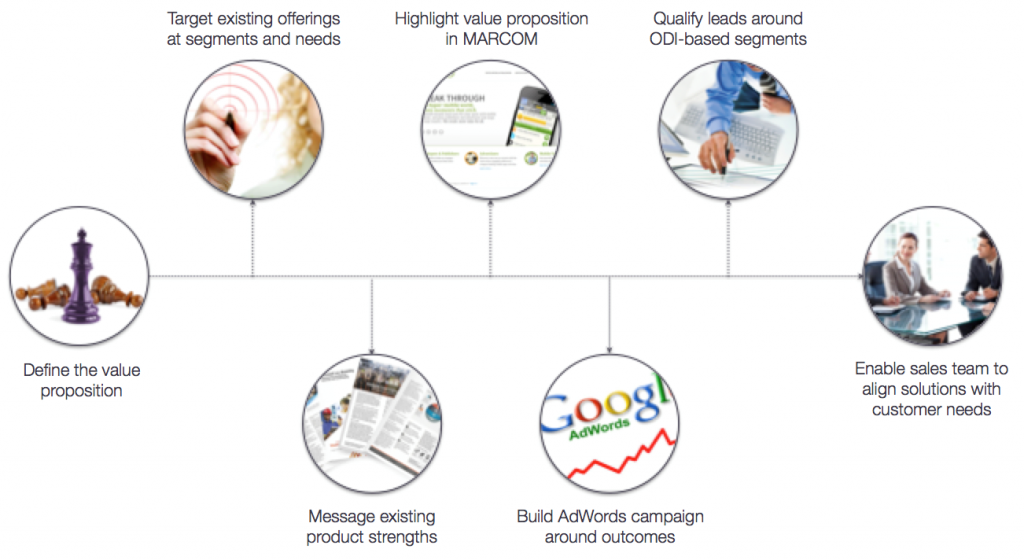Strategyn’s Outcome-Driven Innovation process includes qualitative research methods that are used to discover the job customers are trying to get done and their desired outcomes (a special form of need statement) as they try to get the job done. The process also includes quantitative research methods that are used to discover outcome-based segments of opportunity and to identify which desired outcomes in each segment are underserved—these are needs that are unmet.
With this information in hand, a company has the customer-centric, data-driven inputs it needs to formulate a market strategy.
An effective market strategy should align the strengths of a company’s product offerings with the customer’s unmet needs. This is best accomplished through the marketing activities shown in Figure 1. We recommend the following steps:
- Decide what offerings to target at each of the outcome-based segments.
- Communicate the strengths of those offerings to customers in the target segment.
- Include an outcome-based value proposition in those communications.
- Build an AdWords campaign around unmet needs.
- Assign leads to ODI-based segments.
- Arm the sales team with tools that help them recommend products that address the unique needs of each customer.

Let’s look at how each element of the market strategy is enhanced when it is informed by outcome-based market research.
Decide what offerings to target at each outcome-based segment
The first step in defining the market strategy is to determine which products to target at each of the outcome-based segments that have been discovered. This should be decided based on “fit”: choose the offerings that best satisfy the unmet outcomes of customers in each outcome-based segment. For example, we once helped a manufacturer of industrial pumps discover a segment of customers that were underserved because they frequently encountered conditions that led to cavitation. The company had a number of products that addressed this problem well, but it had never targeted those products at the underserved segment with the right messaging. Knowing to target those offerings at that segment was the first step to success.
Communicate the strengths of those products to customers in the target segment
In one of Strategyn’s first engagements, we helped Cordis discover that one of its existing products satisfied a number of outcomes that were not well satisfied by top competing offerings. The “un-messaged strengths” of this product were subsequently communicated to customers. The result was a significant increase in market share: from 1.5% to 5% over the next six months. Knowing that a product has features that are a competitive strength in a segment of the market is an important insight when it comes to aligning a product portfolio with customer needs.
Include an outcome-based value proposition in those communications
Using ODI, Coloplast’s wound care division discovered a segment of wound care nurses that had 15 underserved outcomes, 10 of which were associated with making sure a wound did not get worse. While Coloplast’s competitors focused on how their products helped wounds heal faster, Coloplast decided to go with an outcome-based value proposition. It promoted the fact that its products would “prevent complications” and highlighted the product features that addressed the associated outcomes. With this new value proposition, the company achieved double-digit growth in less than six months.
Build an AdWords campaign around unmet needs
When potential customers use Google to find and evaluate product alternatives, they rarely start by entering the product name and model because they have yet to discover it. Rather, they enter keywords or phrases that are associated with the “job-to-be-done,” such as a job step or a specific desired outcome they are trying to achieve. With ODI-based research, these keywords and phrases are known to the company, which can use them as the foundation for an AdWords campaign, dramatically improving buyer awareness of its product. Any time a potential customer uses Google to find out how to address an unmet outcome they will see the company’s ad and find its product. A similar strategy can be used to improve SEO results for those same keywords.
Assign leads to ODI-based segments
Many companies process all leads in the same way even though customers have different unmet outcomes. However, using a short 5–10 question survey (on a website or lead-generation tool), a company can accurately determine which outcome-based segment a specific prospect belongs to. With this insight, the prospect can be guided toward the solution that will best address their underserved outcomes.
Arm the sales team with effective sales tools
Lastly, the sales team can be taught how to identify what outcome-based segment a customer or prospect belongs to and guide the conversation accordingly. Approaching a customer with the right value proposition and a clear understanding of their situation and unmet needs goes a long way to building credibility. In 2014, Arm & Hammer’s Animal Nutrition Division used ODI to align its offerings, messaging, and sales efforts around certain underserved segments and outcomes it had discovered. The result was impressive: the Animal Nutrition Division achieved 30% year-to-year revenue growth from 2013 to 2014 without changing its product or pricing—a clear demonstration of the power of aligning marketing and sales efforts around the customer’s job-to-be-done.




Tony, you skipped over the first step – identifying the unmet needs of each segment. I know that this topic is covered in great detail in “What Customers Want” but I think a brief overview would have been good for those who are not familiar with your ODI process.